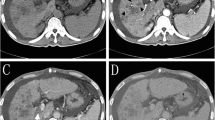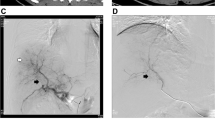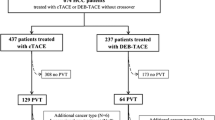Abstract
Objectives
To compare transarterial chemoembolization (TACE)-related hepatic toxicities of conventional TACE (cTACE) and drug-eluting beads TACE (DEB-TACE) in patients with intermediate-stage hepatocellular carcinoma.
Methods
In this retrospective study, 151 consecutive patients undergoing cTACE or DEB-TACE and MRI 3-6 weeks before and after therapy were included. Toxicity was assessed on imaging (global hepatic damages (GHD), overall biliary injuries, biliary cast, bile duct dilatation, intrahepatic biloma, portal thrombosis), and clinico-biological follow-ups. Tumour response, time to progression (TTP), and overall survival were assessed. Factors influencing complication rate were identified by generalized equation logistic regression model.
Results
Biliary injuries and intrahepatic biloma incidence were significantly higher following DEB-TACE (p < 0.001). DEB-TACE showed a significant increased risk of GHD (OR: 3.13 [1.74-5.63], p < 0.001) and biliary injuries (OR: 4.53 [2.37-8.67], p < 0.001). A significant relationship was found between baseline prothrombin value and GHD, biliary injuries and intrahepatic biloma (all p < 0.01), and between the dose of chemotherapy and intrahepatic biloma (p = 0.001). Only TTP was significantly shorter following DEB-TACE compared to cTACE (p = 0.025).
Conclusions
DEB-TACE was associated with increased hepatic toxicities compared to cTACE. GHD, biliary injuries, and intrahepatic biloma were more frequently observed with high baseline prothrombin value, suggesting that cTACE might be more appropriate than DEB-TACE in patients with less advanced cirrhosis.
Key points
• DEB-TACE demonstrated more therapy-related hepatic locoregional complications compared to cTACE.
• TACE-related hepatic locoregional toxicities occurred more frequently with high baseline PT value.
• cTACE may be more appropriate in patients with high baseline PT value.





Similar content being viewed by others
Abbreviations
- AFP:
-
Alpha-fetoprotein
- ALT:
-
Alanine aminotransferase
- AST:
-
Aspartate aminotransferase
- cTACE:
-
Conventional transarterial chemoembolization
- DEB-TACE:
-
Drug-eluting beads transarterial chemoembolization
- GHD:
-
Global hepatic damages
- HCC:
-
Hepatocellular carcinoma
- PT:
-
Prothrombin time
- PVT:
-
Portal vein thrombosis
- OS:
-
Overall survival
- TR:
-
Tumour response
- TTP:
-
Time to progression
References
Llovet JM, Bruix J (2003) Systematic review of randomized trials for unresectable hepatocellular carcinoma: chemoembolization improves survival. Hepatology 37:429–442
Ohishi H, Uchida H, Yoshimura H et al (1985) Hepatocellular carcinoma detected by iodized oil. Use of anticancer agents. Radiology 154:25–29
Bhattacharya S, Novell JR, Winslet MC, Hobbs KE (1994) Iodized oil in the treatment of hepatocellular carcinoma. Br J Surg 81:1563–1571
Boulin M, Schmitt A, Delhom E et al (2016) Improved stability of lipiodol-drug emulsion for transarterial chemoembolisation of hepatocellular carcinoma results in improved pharmacokinetic profile: Proof of concept using idarubicin. Eur Radiol 26:601–609
Marelli L, Stigliano R, Triantos C et al (2007) Transarterial therapy for hepatocellular carcinoma: which technique is more effective? A systematic review of cohort and randomized studies. Cardiovasc Intervent Radiol 30:6–25
Lencioni R, de Baere T, Burrel M et al (2012) Transcatheter treatment of hepatocellular carcinoma with Doxorubicin-loaded DC Bead (DEBDOX): technical recommendations. Cardiovasc Intervent Radiol 35:980–985
Hong K, Khwaja A, Liapi E, Torbenson MS, Georgiades CS, Geschwind JF (2006) New intra-arterial drug delivery system for the treatment of liver cancer: preclinical assessment in a rabbit model of liver cancer. Clin Cancer Res 12:2563–2567
Johnson PJ, Kalayci C, Dobbs N et al (1991) Pharmacokinetics and toxicity of intraarterial adriamycin for hepatocellular carcinoma: effect of coadministration of lipiodol. J Hepatol 13:120–127
Lammer J, Malagari K, Vogl T et al (2010) Prospective randomized study of doxorubicin-eluting-bead embolization in the treatment of hepatocellular carcinoma: results of the PRECISION V study. Cardiovasc Intervent Radiol 33:41–52
Varela M, Real MI, Burrel M et al (2007) Chemoembolization of hepatocellular carcinoma with drug eluting beads: efficacy and doxorubicin pharmacokinetics. J Hepatol 46:474–481
Malagari K, Pomoni M, Spyridopoulos TN et al (2011) Safety profile of sequential transcatheter chemoembolization with DC Bead: results of 237 hepatocellular carcinoma (HCC) patients. Cardiovasc Intervent Radiol 34:774–785
Guiu B, Deschamps F, Aho S et al (2012) Liver/biliary injuries following chemoembolisation of endocrine tumours and hepatocellular carcinoma: lipiodol vs. drug-eluting beads. J Hepatol 56:609–617
Bhagat N, Reyes DK, Lin M et al (2013) Phase II study of chemoembolization with drug-eluting beads in patients with hepatic neuroendocrine metastases: high incidence of biliary injury. Cardiovasc Intervent Radiol 36:449–459
Brandsaeter B, Schrumpf E, Clausen OP, Abildgaard A, Hafsahl G, Bjoro K (2004) Recurrent sclerosing cholangitis or ischemic bile duct lesions--a diagnostic challenge? Liver Transpl 10:1073–1074
Pfau PR, Kochman ML, Lewis JD et al (2000) Endoscopic management of postoperative biliary complications in orthotopic liver transplantation. Gastrointest Endosc 52:55–63
Clermonts SH, van Dam RM (2014) Obstructive putty-like cast of the biliary tree. Hepatobiliary Surg Nutr 3:47–49
Benninger J, Grobholz R, Oeztuerk Y et al (2005) Sclerosing cholangitis following severe trauma: description of a remarkable disease entity with emphasis on possible pathophysiologic mechanisms. World J Gastroenterol 11:4199–4205
Gelbmann CM, Rummele P, Wimmer M et al (2007) Ischemic-like cholangiopathy with secondary sclerosing cholangitis in critically ill patients. Am J Gastroenterol 102:1221–1229
Kwon ON, Cho SH, Park CK, Mun SH (2012) Biliary cast formation with sclerosing cholangitis in critically ill patient: case report and literature review. Korean J Radiol 13:358–362
Chung J, Yu JS, Chung JJ, Kim JH, Kim KW (2010) Haemodynamic events and localised parenchymal changes following transcatheter arterial chemoembolisation for hepatic malignancy: interpretation of imaging findings. Br J Radiol 83:71–81
Gillmore R, Stuart S, Kirkwood A et al (2011) EASL and mRECIST responses are independent prognostic factors for survival in hepatocellular cancer patients treated with transarterial embolization. J Hepatol 55:1309–1316
Golfieri R, Giampalma E, Renzulli M et al (2014) Randomised controlled trial of doxorubicin-eluting beads vs conventional chemoembolisation for hepatocellular carcinoma. Br J Cancer 111:255–264
Joskin J, de Baere T, Auperin A et al (2015) Predisposing factors of liver necrosis after transcatheter arterial chemoembolization in liver metastases from neuroendocrine tumor. Cardiovasc Intervent Radiol 38:372–380
Katabathina VS, Dasyam AK, Dasyam N, Hosseinzadeh K (2014) Adult bile duct strictures: role of MR imaging and MR cholangiopancreatography in characterization. Radiographics 34:565–586
Yu JS, Kim KW, Jeong MG, Lee DH, Park MS, Yoon SW (2002) Predisposing factors of bile duct injury after transcatheter arterial chemoembolization (TACE) for hepatic malignancy. Cardiovasc Intervent Radiol 25:270–274
Demachi H, Matsui O, Kawamori Y, Ueda K, Takashima T (1995) The protective effect of portoarterial shunts after experimental hepatic artery embolization in rats with liver cirrhosis. Cardiovasc Intervent Radiol 18:97–101
Kobayashi S, Nakanuma Y, Matsui O (1994) Intrahepatic peribiliary vascular plexus in various hepatobiliary diseases: a histological survey. Hum Pathol 25:940–946
Itai Y, Matsui O (1997) Blood flow and liver imaging. Radiology 202:306–314
Sakamoto I, Iwanaga S, Nagaoki K et al (2003) Intrahepatic biloma formation (bile duct necrosis) after transcatheter arterial chemoembolization. AJR Am J Roentgenol 181:79–87
Van Beers BE, Leconte I, Materne R, Smith AM, Jamart J, Horsmans Y (2001) Hepatic perfusion parameters in chronic liver disease: dynamic CT measurements correlated with disease severity. AJR Am J Roentgenol 176:667–673
Gulberg V, Haag K, Rossle M, Gerbes AL (2002) Hepatic arterial buffer response in patients with advanced cirrhosis. Hepatology 35:630–634
Duran R, Chapiro J, Schernthaner RE, Geschwind JF (2015) Systematic review of catheter-based intra-arterial therapies in hepatocellular carcinoma: state of the art and future directions. Br J Radiol 88:20140564
Lewis AL, Taylor RR, Hall B, Gonzalez MV, Willis SL, Stratford PW (2006) Pharmacokinetic and safety study of doxorubicin-eluting beads in a porcine model of hepatic arterial embolization. J Vasc Interv Radiol 17:1335–1343
Gao J, Qian F, Szymanski-Exner A, Stowe N, Haaga J (2002) In vivo drug distribution dynamics in thermoablated and normal rabbit livers from biodegradable polymers. J Biomed Mater Res 62:308–314
Acknowledgments
The scientific guarantor of this publication is Alban Denys. The authors of this manuscript declare no relationships with any companies, whose products or services may be related to the subject matter of the article. The authors state that this work has not received any funding. One of the authors has significant statistical expertise. Institutional Review Board approval was obtained. Written informed consent was waived by the Institutional Review Board. Methodology: retrospective, observational, performed at one institution.
Author information
Authors and Affiliations
Corresponding author
Electronic supplementary material
Below is the link to the electronic supplementary material.
ESM 1
(DOC 23 kb)
Rights and permissions
About this article
Cite this article
Monier, A., Guiu, B., Duran, R. et al. Liver and biliary damages following transarterial chemoembolization of hepatocellular carcinoma: comparison between drug-eluting beads and lipiodol emulsion. Eur Radiol 27, 1431–1439 (2017). https://doi.org/10.1007/s00330-016-4488-y
Received:
Revised:
Accepted:
Published:
Issue Date:
DOI: https://doi.org/10.1007/s00330-016-4488-y




